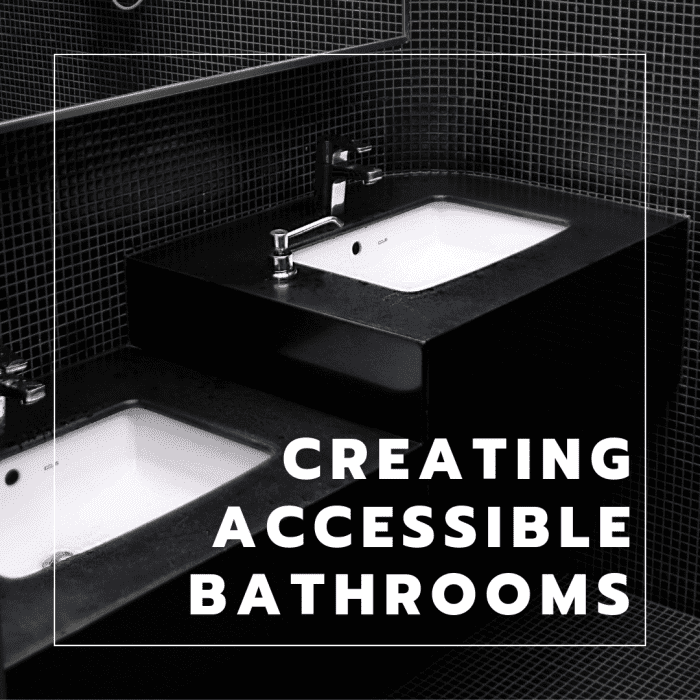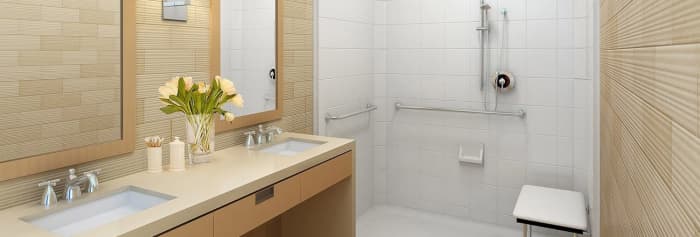Wheelchair Accessible Bathroom Design
Ashley represents an independent and locally owned professional plumbing team.

Creating Accessible Bathrooms
Harry Cunningham
According to the United States Census Bureau, the percentage of residents age 65 and older has increased by nearly three percent since the turn of the century. This is largely attributed to the baby boomer generation, who started reaching this threshold in 2005. Those still reaching retirement age, including nearly 72.5 million individuals born in the last year of the baby boom, will add to this number by 2030. By 2050, the percentage of the population over 65 is anticipated to increase to 20, which would be a 5% increase from today.
The population boom is also compounded by advances in medical science. Today, it is projected that one in twenty women and one in forty men currently age forty or younger will reach 100 years of age. In 2030, the number of centenarians is expected to more than double. However, longevity still comes with its challenges.

Per the Center for Disease Control, 16.3% of adults are currently described as living with "any form of physical functioning difficulty." In particular, 12% individuals over age 75 require help with personal care from other persons. As these numbers are expected to increase, there is a push to find new ways to allow independence regardless of age or ability by adapting the environment to the individual rather than the other way around.
One of the most challenging areas for these individuals is the bathroom. It is often an area that is designed to be compact, with several fixtures that require fine motor skills, repeated up and down movement and balance. Here are some examples of changes, both big and small, that can drastically add to the quality of life for these individuals by granting independence that had previously been restricted.

Mobility and Spacing
In general, the area should be wide enough for any mobility assistance devices, but the Americans with Disabilities Act determines a five-foot radius turning radius is required for wheelchair access. Doors should be 34" wide and swing outward to allow more space in the room when possible. A 30" x 48" space should be provided in front of each fixture and be accessible from both a forward and parallel approach. However, these measurements can be flexible depending on the space allowed and the type of device used.
Additionally, the floor should be completely flush if at all possible. This allows unrestricted movement for any individual using the space and ample room to maneuver as needed. Removing steps, damaged or warped flooring, and other types of floor dividers can also prevent trips and falls, which are the leading cause of fatal injuries among older adults. This also includes considering floor mats, which should be as flat as possible and designed to avoid catching.

Toilet and Sink
Per ADA guidelines, toilet seats should be between 17" and 19" high to comfortably seat all users. Thicker seat covers can be used to make up the difference with tighter budgets or when a full replacement is simply not possible. At least one grab bar 18" from the nearest wall is suggested, but two bars on either side at 36" apart is ideal. For smaller areas, swing-away or retractable bars can allow both maximum mobility and space. If another stable fixture is nearby, such as a sink or wall, affixing grab bars to these can create a more comfortable space.
Read More From Dengarden
To avoid unnecessary twisting, toilet paper fixtures should not be placed behind the bowl. Additional supplies should also be easily accessible. A bidet might also be considered for those who have trouble with twisting movement and flexibility. It allows for more privacy and even better hygiene by using water jets to clean all areas after use. While this option can be built into a toilet replacement, it can also be added to the current fixtures as well.

Shower and Bath
Regarding size and design, the ideal shower would be flush with no curb. Instead, a gentle slope leads to direct water to the drain. It should be 36" wide for someone using a transfer seat and 60" wide for an individual in a wheelchair to maneuver. A built in shower seat is recommended, at a height between 17" to 19", and can either be rolling or fixed. A stool or plastic chair can also be used and may be preferred for easy removal in shared bathrooms.
Many often overlooked points for shower design revolve around minimizing the risk of slips and falls. For example, glass partitions are preferred over curtains to allow more lighting. Overhead or directional light fixtures or LED lighting strips can also provide better lighting in the shower. Textured flooring is suggested or a slatted wood tray over concrete. For a temporary solution, slippery surfaces may also be avoided with high-quality non-slip mats. On these same lines, grab bars should be in place on each wall of a roll-in shower and two walls in transfer showers.

Walk-in tubs are an excellent option to avoid users having to lift themselves over the side of the tub, which poses a significant risk of injury. Many, if not all, include low entry and built in seating. Several come with additional components such as seat warming and whirlpool jets. These features have added health benefits. For example, individuals suffering from skeletal ailments, such as tendinitis and arthritis, benefit from increased blood circulation spurred from the jets and muscle relaxation created from the heat, along with reduced inflammation.
Handheld showerheads are highly recommended for any style of shower or bath. Not only does this better accommodate a seated user, it also prevents excessive movement that could result in slips or falls and increases reach and, consequently, independence. These should also include at least 60" of hose.

Knobs, Switches and Other Small Fixtures
Some other small challenges are found in unexpected places. Switches and knobs in particular can be difficult for individuals struggling with fine motor skills. Lever style handles on doors and faucets can put less strain on the users and offer greater independence. Rocker light switches, which are wide and flat, or motion sensor light switches, which have a button for use as well, are also options for increased ease.
Shelves along with towel racks and hooks should all be within reach without strain or stretching. Storage or holding areas should be clutter or overfilled. This prevents dropping and spills that then require kneeling or reaching that may be difficult for others. It may even lead to an injury, either directly for from a slip or fall.
Another thing to consider, especially for those with trouble adjusting the temperature handle, is an anti-scald mixing valve. This is installed behind the current handle and controls the temperature of the water. Once in place, the suggested maximum temperature to set it to is 120°. Anything higher can burn instantly.
In Their Shoes
While guidelines can help with creating a starting point, it is important to remember that every individual is unique and the challenges of one user may vary widely from another. One of the best ways to get a better understanding of the needs of others is to view it from their perspective. Take a moment to go through the area the same way the user would and make note of challenges encountered along the way. It may come as a surprise how many are found along the way.
Wheelchair Accessible Bathroom Design
Source: https://dengarden.com/remodeling/Creating-an-Accessible-Bathroom-Design

0 komentar:
Posting Komentar